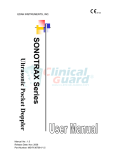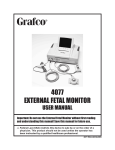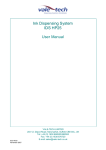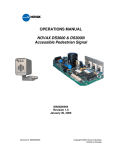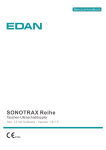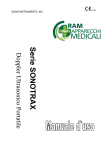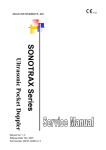Download Manual - Cardiac Direct
Transcript
About this Manual P/N: 01.54.36708-17 Release Date: Aug. 2010 © Copyright EDAN INSTRUMENTS, INC. 2007-2010. All rights reserved. Statement This manual will help you understand the operation and maintenance of the product better. It is reminded that the product shall be used strictly complying with this manual. User’s operation failing to comply with this manual may result in malfunction or accident for which Edan Instruments, Inc. (hereinafter called EDAN) can not be held liable. EDAN owns the copyrights of this manual. Without prior written consent of EDAN, any materials contained in this manual shall not be photocopied, reproduced or translated into other languages. Materials protected by the copyright law, including but not limited to confidential information such as technical information and patent information are contained in this manual, the user shall not disclose such information to any irrelevant third party. The user shall understand that nothing in this manual grants him, expressly or implicitly, any right or license to use any of the intellectual properties of EDAN. EDAN holds the rights to modify, update, and ultimately explain this manual. Responsibility of the Manufacturer EDAN only considers itself responsible for any effect on safety, reliability and performance of the equipment if: Assembly operations, extensions, re-adjustments, modifications or repairs are carried out by persons authorized by EDAN, and The electrical installation of the relevant room complies with national standards, and The instrument is used in accordance with the instructions for use. Upon request, EDAN may provide, with compensation, necessary circuit diagrams, and other information to help qualified technician to maintain and repair some parts, which EDAN may define as user serviceable. Product Information Product Name: Ultrasonic Pocket Doppler Model: SONOTRAX Lite, SONOTRAX Basic, SONOTRAX Basic A, SONOTRAX Pro, SONOTRAX II, SONOTRAX II Pro I Terms Used in this Manual This guide is designed to give key concepts on safety precautions. WARNING A WARNING label advises against certain actions or situations that could result in personal injury or death. CAUTION A CAUTION label advises against actions or situations that could damage equipment, produce inaccurate data, or invalidate a procedure. NOTE A NOTE provides useful information regarding a function or a procedure. II Table of Contents Chapter 1 Safety Guide..............................................................................................................1 1.1 Intended Use....................................................................................................................1 1.2 Safety Precautions ...........................................................................................................1 1.3 Symbols...........................................................................................................................3 Chapter 2 Doppler and Accessories..........................................................................................4 2.1 Features ...........................................................................................................................4 2.2 Appearance......................................................................................................................5 2.3 Display Panel...................................................................................................................6 2.4 Buttons ............................................................................................................................7 2.5 Socket ..............................................................................................................................8 2.6 Probes ..............................................................................................................................9 2.6.1 Waterproof Obstetrical Probes ..............................................................................9 2.6.2 Waterproof Vascular Probes .................................................................................9 2.6.3 Probe Socket........................................................................................................10 2.7 Batteries.........................................................................................................................11 Chapter 3 Operation ................................................................................................................12 3.1 Opening the Package and Checking..............................................................................12 3.2 Installing/Replacing Battery..........................................................................................12 3.3 Probe Operation.............................................................................................................14 3.4 Switching on the Doppler..............................................................................................15 3.5 Modes Setting................................................................................................................15 3.5.1 Real-time FHR Display Mode (Mode 1).............................................................16 3.5.2 Averaged FHR Display Mode (Mode 2).............................................................16 3.5.3 Manual Mode (Mode 3) ......................................................................................16 3.5.4 Backlight Brightness Setting Mode (Mode 4).....................................................16 3.5.5 Record Sampling Frequency Setting Mode (Mode 5) ........................................16 3.6 Fetal Heart (FH) Examining..........................................................................................17 3.7 FH Sound Recording and Playing by Build-in Recorder..............................................18 3.8 FH Sound Recording by PC ..........................................................................................18 3.8.1 Recording Sounds ...............................................................................................18 3.8.2 Playing Sound Files.............................................................................................20 3.8.3 Burning CD or Sending in Email ........................................................................20 3.8.4 Record Troubleshooting......................................................................................20 3.9 Vascular Examining (Optional) ....................................................................................23 3.10 Switching Off the Doppler ..........................................................................................25 3.11 Replacing/Charging the Battery ..................................................................................25 Chapter 4 Product Specifications ...........................................................................................27 Chapter 5 Maintenance ...........................................................................................................31 5.1 Maintenance ..................................................................................................................31 III 5.2 Cleaning ........................................................................................................................31 5.3 Disinfection of the Probe...............................................................................................31 Chapter 6 Warranty and After-Sales Service........................................................................32 6.1 Warranty........................................................................................................................32 6.2 After-Sales Service........................................................................................................32 Appendix 1 Ordering Information .........................................................................................33 Appendix 2 EMC Information-Guidance and Manufacture’s Declaration .......................34 A2.1 Electromagnetic Emissions - for all Equipment and Systems....................................34 A2.2 Electromagnetic Immunity - for all Equipment and Systems ....................................34 A2.3 Electromagnetic Immunity - for all Equipment and Systems that are not Life-supporting....................................................................................................................35 A2.4 Recommended Separation Distances .........................................................................36 Appendix 3 Overall Sensitivity................................................................................................37 IV SONOTRAX Series Ultrasonic Pocket Doppler User Manual Safety Guide Chapter 1 Safety Guide NOTE: This user manual is written to cover the maximum configuration. Therefore, your model may or may not have some of the parameters and functions described, depending on what you have ordered. 1.1 Intended Use The SONOTRAX Series Ultrasonic Pocket Dopplers are intended to be used by health care professionals including registered nurses, practical nurses, midwives, ultrasound technicians, and physicians assistants, by prescription from licensed physicians in hospitals, clinics and private offices. The 2 MHz and/or 3 MHz waterproof probes are indicated for the detection of fetal heart rate from early gestation thru delivery and as a general indication of fetal well being. They can also be used to verify fetal heart viability following patient trauma. The 4 MHz, 5 MHz and/or 8 MHz waterproof vascular probes are indicated for the detection of blood flow in veins and arteries for assisting in the detection of peripheral vascular disease. 1.2 Safety Precautions This unit is internally powered equipment, and it is an IEC/EN 60601-1 Type B applied part. Type B protection means that the connection between the equipment and personnel complies with permitted leakage currents and dielectric strength of IEC/EN 60601-1. WARNING and CAUTION messages must be observed. To avoid the possibility of injury, observe the following precautions during the operation of the device. WARNING 1 This device is not intended for treatment. 2 This device is not explosion-proof and can not be used in the presence of flammable anaesthetics. 3 Do not touch the signal input/output connector and the patient simultaneously. 4 We recommend that exposure to ultrasound should be kept as low as reasonably achievable. This is considered to be good practice and should be observed at all time. 5 Only use probes provided by the manufacturer. 6 The stretching length of probe cable should be less than two meters in order to avoid the cable breaking away from the probe socket. -1- SONOTRAX Series Ultrasonic Pocket Doppler User Manual Safety Guide WARNING 7 Check if the equipment has visible evidence of damage that may affect the personnel’s safety or the device’s capability before use. If the damage is evident, replace the defective part(s) before use. 8 Accessory equipment connected to the analog and digital interfaces must be certified according to the respective IEC/EN standards (e.g. IEC/EN 60950 for data processing equipment and IEC/EN 60601-1 for medical equipment). Furthermore all configurations shall comply with the valid version of the system standard IEC/EN 60601-1-1. Anybody who connects additional equipment to the signal input connector or signal output connector to configure a medical system must ensure that the system complies with the requirements of the valid version of the system standard IEC/EN 60601-1-1. If in doubt, consult our technical service department or your local distributor. 9 The device shall only be used when the battery cover is closed. 10 Do not throw batteries in fire as this may cause explosion. 11 Do not attempt to charge normal alkaline batteries. They may leak, catch fire or even explode. 12 Replacement of the battery shall be done at least 1.5 meters away from patients. 13 Charge the lithium-ion polymer battery with the special charger supplied by the manufacturer. CAUTION 1 Federal (U.S.) law restricts this device to sale by or on the order of a physician. 2 Refer servicing to qualified personnel. 3 The main unit is designed for continuous operation and is ‘ordinary’. Do not immerse it in any liquid (i.e. not drip or splash-proof). 4 Electromagnetic Interference - Ensure that the environment in which the device is operated is not subject to any source of strong electromagnetic interference, such as radio transmitters, mobile telephones, etc. 5 SONOTRAX Series Ultrasonic Pocket Doppler is a tool to aid the healthcare professional and should not be used in place of normal fetal monitoring. 6 Keep the device in a clean environment and avoid vibration during storage. 7 The device and accessories are to be disposed of according to local regulations after their useful lives. Alternatively, they can be returned to the dealer or the manufacturer for recycling or proper disposal. Batteries are hazardous waste. Do NOT dispose them together with house-hold garbage. At the end of their life hand the batteries over to the applicable collection points for the recycling of waste batteries. For more detailed information about recycling of this product or battery, please contact your local Civic Office, or the shop where you purchased the product. -2- SONOTRAX Series Ultrasonic Pocket Doppler User Manual Safety Guide 1.3 Symbols The symbol indicates that the device complies with the European Council Directive 93/42/EEC concerning medical devices. Type B applied part. The symbol indicates that the device should be sent to the special agencies according to local regulation for separate collection after its useful life. Consult Instructions for Use Stand-by CE mark Polarity of d.c. power connector Class II equipment Can be used in residential areas Attention. Refer to accompanying documents. Part Number Serial Number Date Of Manufacture Manufacturer Authorized Representative in the European Community General symbol for recovery / recyclable Rx only (U.S.) Federal (U.S.) Law restricts this device to sale by or on the order of a physician -3- SONOTRAX Series Ultrasonic Pocket Doppler User Manual Doppler and Accessories Chapter 2 Doppler and Accessories 2.1 Features There are six different models available: SONOTRAX Lite, SONOTRAX Basic, SONOTRAX Basic A, SONOTRAX Pro, SONOTRAX II and SONOTRAX II Pro. SONOTRAX Lite is for simple auscultation (intermittent listening). SONOTRAX Basic, SONOTRAX Basic A, SONOTRAX Pro, SONOTRAX II and SONOTRAX II Pro not only detect fetal heart sound; they also display the fetal heart rate on a LCD screen. The features of the Dopplers are listed in the following chart: Model Function SONOTRAX SONOTRAX SONOTRAX SONOTRAX SONOTRAX SONOTRAX Lite Basic Basic A Pro II II Pro √ √ √ √ √ √ √ √ √ LCD Display LCD Backlight Mini USB Socket Probe Probe Detecting √ √ √ √ √ √ √ √ √ √ √ √ √ √ √ √ √ Probe Identifying Built-in Speaker √ √ √ √ √ √ Attached Earphone √ √ √ √ √ √ Volume Adjustable √ √ √ √ √ √ √ √ √ √ √ Modes Switching Audio Recording and Playing √ Alkaline Battery (9V) √ √ √ √ Rechargeable NI-MH Battery (8.4V) √ √ √ √ Lithium-ion Battery Polymer Battery Charged Machine in Low Battery Detecting & indicating √ Auto Shutdown Vascular Examining √ √ √ √ √ √ √ √ √ √ √ √ √ √ √ √ √ √ √ √ √ -4- SONOTRAX Series Ultrasonic Pocket Doppler User Manual Doppler and Accessories 2.2 Appearance NOTE: The pictures and interfaces in this manual are for reference only. Take 2.0MHz obstetrical probe for example. Figure 2-1 Front Panel Figure 2-2 Rear Panel Figure 2-3 Top Panel Figure 2-4 Left Panel -5- SONOTRAX Series Ultrasonic Pocket Doppler User Manual Doppler and Accessories 2.3 Display Panel SONOTRAX Lite has a LED in the bottom left corner of its display panel area. When powered on, the LED turns green. If the LED flashes in green, it indicates that the probe is disconnected or poorly connected. If the LED flashes in orange, it indicates that the battery is too low to support working. Change for a new battery or charge the rechargeable battery in time. For SONOTRAX Basic, SONOTRAX Basic A, SONOTRAX Pro, SONOTRAX II and SONOTRAX II Pro, while self-testing, the LCD is shown as follows: Playing Working Mode Communication FHR Refresh Frequency Recording FHR Display Battery Indicator Probe Type Figure 2-5 LCD display status while self-testing Working Mode: It indicates the mode in which the Doppler is working. FHR Refresh Frequency: When the examination starts, the heart shape symbol flashes, and its frequency indicates the FHR refreshing frequency. Battery Indicator: For SONOTRAX Basic, a battery symbol appears on the LCD after it’s powered on. When the battery is low, this symbol flashes; the Doppler will shut down automatically after 7 seconds. For SONOTRAX Basic A, SONOTRAX Pro, SONOTRAX II and SONOTRAX II Pro, there is a battery symbol on the LCD. The green panes in it indicate the battery electric energy. The green panes disappear gradually with the energy consumption. When the electric energy is low, the empty battery symbol flashes. Approximately five minutes later, the Doppler shuts down automatically. PLAYING: PLAYING is lit when the Doppler is playing the recorded fetal heart sound. RECORDING: RECORDING is lit when the Doppler is recording fetal heart sound. -6- SONOTRAX Series Ultrasonic Pocket Doppler User Manual Doppler and Accessories FHR Displaying: This area displays the fetal heart rate value, and its unit is bpm (beat per minute). Probe Type: The Doppler can detect and identify the probe: when the probe is not connected or poorly connected, the “---” symbol and “MHz” symbol on the LCD screen flash; when the probe is well connected, the flashing stops, and the probe type is shown on the LCD screen. Communication The Doppler can communicate with PC. This function is reserved. 2.4 Buttons At most there are four push buttons (Power, MODE, START/STOP and REC/PLAY) and a volume control button on the main unit of the Doppler. Their primary functions are as follows: (1) Power Button Function: Switch on or off the Doppler. (2) MODE Button (Only for SONOTRAX Basic / SONOTRAX Basic A / SONOTRAX Pro / SONOTRAX II / SONOTRAX II Pro) Function: Select the working mode. (3) START/STOP Button (Only for SONOTRAX Basic / SONOTRAX Basic A / SONOTRAX Pro / SONOTRAX II / SONOTRAX II Pro) Function: Start/ stop examining (Mode 3)/ setting (Mode 4 and Mode 5). (4) REC/PLAY (Only for SONOTRAX Pro/ SONOTRAX II Pro) Function: Start/ stop recording or playing fetal heart sound. (5) Volume Control Indicator Function: Adjust volume. Rotate the volume gear clockwise to turn up the volume, while rotate it anti-clockwise to turn down the volume. -7- SONOTRAX Series Ultrasonic Pocket Doppler User Manual Doppler and Accessories 2.5 Socket The two sockets are located on the top panel of the Doppler. (1) Earphone socket : the earphone or line-in cable connects to the Doppler via this socket. Figure 2-6 Line-in Cable Signal Interface 1 4 5 2 3 1 GND 2 Signal 3 Signal 4 Signal 5 Signal (2) Charge socket : the special lithium-ion polymer battery charger connects to the Doppler via this socket. (For SONOTRAX II and SONOTRAX II Pro only) NOTE: Accessory equipment connected to the analog and digital interfaces must be certified according to the respective IEC/EN standards (e.g. IEC/EN 60950 for data processing equipment and IEC/EN 60601-1 for medical equipment). Furthermore all configurations shall comply with the valid version of the system standard IEC/EN 60601-1-1. Anybody who connects additional equipment to the signal input connector or signal output connector to configure a medical system must ensure that the system complies with the requirements of the valid version of the system standard IEC/EN 60601-1-1. If in doubt, consult our technical service department or your local distributor. -8- SONOTRAX Series Ultrasonic Pocket Doppler User Manual Doppler and Accessories 2.6 Probes 2.6.1 Waterproof Obstetrical Probes 2.0MHz/3.0MHz waterproof obstetrical probes can be connected to the main unit for fetal heart examining. The 2MHz obstetrical probe features in deep penetration and is designed for use during the third trimester pregnancy. The 3MHz obstetrical probe features in high sensitivity and is designed for use during the entire pregnancy. Figure 2-7 2.0/3.0MHz obstetrical probe The main information on the probe is as follows: CD2.0/3.0: CD stands for continuous wave Doppler, 2.0/3.0 means central frequency is 2.0 MHz/3.0MHz. MS3-14320: Part number of the 2.0MHz waterproof probe. MS3-14321: Part number of the 3.0MHz waterproof probe. A: Version number of the probe. SNxxxxx: Serial number of the probe. Waterproof: The probe is waterproof. IPX8: Water Ingress Protection Code. It indicates that this probe can work continuously for five hours when being immersed into water within one meter deep. 2.6.2 Waterproof Vascular Probes The 4.0MHz/5.0MHz/8.0MHz waterproof vascular probes can be connected to the main unit for artery and vein blood flow examining. -9- SONOTRAX Series Ultrasonic Pocket Doppler User Manual Figure 2-8 Doppler and Accessories 4.0/5.0/8.0MHz Vascular Probes The main information on the probe is as follows: CD4.0/CD5.0/CD8.0: CD means continuous wave Doppler, 4.0/5.0/8.0 means the central frequency is 4.0/5.0/8.0 MHz. MS3-14346: Part number of 4.0MHz waterproof vascular probe. MS3R-104822: Part number of 5.0MHz waterproof vascular probe. MS3-14347: Part number of 8.0MHz waterproof vascular probe. A: the version number of this vascular probe. SNxxxxx: Serial number of this vascular probe. Waterproof: The probe is waterproof. IPX8: Water Ingress Protection Code. It indicates that this probe can work continuously for five hours when being immersed into water within one meter deep. 2.6.3 Probe Socket The probe socket is as shown in figure 2-9. Jack 1 2 3 4 5 6 Figure 2-9 Probe socket - 10 - Definition Power Supply Signal Probe Coding 1 Probe Coding 2 GND (Shell) GND SONOTRAX Series Ultrasonic Pocket Doppler User Manual Doppler and Accessories Connect the 2.0MHz/3.0MHz obstetrical probes or 4.0MHz/5.0MHz/8.0MHz vascular probes supplied by the manufacturer to the Doppler through the probe socket. CAUTION 1 Do not try to connect any other plug to the probe socket except the plug of the probes mentioned above. 2 Do not stretch the probe cable for more than two meters long. 2.7 Batteries SONOTRAX Lite, SONOTRAX Basic, SONOTRAX Basic A and SONOTRAX Pro are powered either by 9V alkaline batteries (IEC Type No. 6LR61/6LF22 or equivalent) or by rechargeable NI-MH batteries (8.4V). SONOTRAX II and SONOTRAX II Pro are powered by lithium-ion polymer batteries supplied by the manufacturer. Alkaline Battery Rechargeable NI-MH Battery Figure 2-12 Batteries - 11 - Lithium-ion Polymer Battery SONOTRAX Series Ultrasonic Pocket Doppler User Manual Operation Chapter 3 Operation NOTE: To ensure that the Doppler works properly, please read this chapter and Chapter 1 Safety Guide before operation; follow the steps when connecting all the components. 3.1 Opening the Package and Checking Open the package; take out the Doppler and accessories carefully. Keep the package for possible future transportation or storage. Check the components according to the packing list. Check for any mechanical damage. Check all the cables and accessories. If there is any problem, contact us or your local distributor immediately. 3.2 Installing/Replacing Battery To install or replace a battery, perform the following steps: 1) Open the battery compartment. Turn the Doppler upside down. Press the two stripe marks on the battery compartment cover with your thumbs respectively. Slide the cover in the direction of the arrow with mild force to open the compartment. Figure 3-1 Opening battery compartment 2) Install / Replace the battery. Remove the old battery from the connector if necessary. NOTE: Do not use excessive force when disconnecting the battery and the connector, in case the connector falls off. Connect the new battery to the battery connector, and then put the assembly into the battery compartment. (Figure 3-2 a) - 12 - SONOTRAX Series Ultrasonic Pocket Doppler User Manual Operation For SONOTRAX II and SONOTRAX II Pro, insert the battery connector into the battery socket in the compartment. (Figure 3-2 b) (a) (b) Figure 3-2 Connecting battery connector 3) Close the compartment. Slide the cover back to close the battery compartment. Figure 3-3 Closing battery compartment CAUTION 1 Take out the alkaline/NI-MH battery and keep it in a cool and dry environment if the Doppler is not used for an extended period. 2 Do not remove the lithium-ion polymer battery frequently after the initial installation. If the Doppler is not used for an extended period, charge the battery at least every three months. - 13 - SONOTRAX Series Ultrasonic Pocket Doppler User Manual Operation 3.3 Probe Operation (1) Taking out the probe Hold the main unit with one hand. Pinch the probe head and pull it outwards with mild force, and then take out the whole probe slantwise in the direction of the arrow. Figure 3-4 Taking out the probe (2) Placing the probe Hold the main unit with one hand. Place the probe tail into the bottom right part of the probe holder, and then push the probe head in until it clicks into the holder. Figure 3-5 Placing the probe CAUTION Do not take out or place the probe when the Doppler is on. Remember to take out the probe before switching on the Doppler, and place the probe after switching off the Doppler. - 14 - SONOTRAX Series Ultrasonic Pocket Doppler User Manual Operation (3) Replacing the Probe Remove the old probe: Switch off the Doppler; hold the main unit with one hand; pinch the jacket of the mini USB socket and pull it out with mild force; take out the probe. CAUTION Do not pull the probe cable directly. Figure 3-6 Removing the probe Replace it with a new probe: Put the USB socket of new probe into the probe interface of the Doppler. NOTE: Place the temporarily unused probe carefully and avoid falling off, splash or stress, etc. When the Doppler is not used for a long time, it’s recommended to connect the probe to the Doppler and keep them safely in the package. 3.4 Switching on the Doppler Press the POWER button on the front panel to switch on the Doppler. 3.5 Modes Setting SONOTRAX Basic, SONOTRAX Basic A, SONOTRAX Pro, SONOTRAX II and SONOTRAX II Pro have different modes available. Press the MODE button to switch to the next mode. After self testing, SONOTRAX Basic enters the previous mode in which the Doppler worked, and other models automatically enters mode 1. - 15 - SONOTRAX Series Ultrasonic Pocket Doppler User Manual Operation 3.5.1 Real-time FHR Display Mode (Mode 1) When the Doppler works in this mode, the working mode on LCD displays 1. As soon as a fetal heart signal is detected, the heart shape on LCD flashes and the FHR display area displays the real-time FHR value. 3.5.2 Averaged FHR Display Mode (Mode 2) Keep pressing the MODE button until the working mode on LCD displays 2. The heart shape on LCD flashes when fetal heart signal is detected, and the FHR value indicates the average value of every eight beats. 3.5.3 Manual Mode (Mode 3) Keep pressing the MODE button until the working mode on LCD displays 3. Press the START/STOP button once and start counting immediately, viz. count one at the moment when the button is pressed. The LCD displays the flashing heart shape symbol and “---”. Press the button again on the 10th count (after nine beat intervals). The Doppler automatically calculates and displays the average FHR over the 10 beats. This rate value will not disappear until another measurement starts or the mode is changed. 3.5.4 Backlight Brightness Setting Mode (Mode 4) This mode is only available with SONOTRAX Basic A, SONOTRAX Pro, SONOTRAX II and SONOTRAX II Pro. Keep pressing the MODE button until the working mode on LCD displays 4. Press the START/STOP button to disable or enable the backlight. “OFF” displayed on the LCD means the backlight is disabled, while “ON” means the backlight is enabled. NOTE: The setting in this mode will be saved automatically after mode change or normal power off. 3.5.5 Record Sampling Frequency Setting Mode (Mode 5) This mode is only available with SONOTRAX Pro and SONOTRAX II Pro. Keep pressing the MODE button until the working mode on LCD displays 5. Press the START/STOP button, the sampling frequency switches between 4 and 8 on the LCD. “4” means the frequency is 4KHz, and the longest record time is 480 seconds; while “8” means 8KHz, and the longest record time is 240 seconds. - 16 - SONOTRAX Series Ultrasonic Pocket Doppler User Manual Operation NOTE: 1 The setting under this mode will be saved automatically after mode switches or normal power off. 2 After changing frequency, the records related to the original frequency will be cleared automatically. 3.6 Fetal Heart (FH) Examining FH examining with 2.0MHz/3.0MHz obstetrical probe 1) Confirm the fetus’s position by hand. 2) Determine the probable probe location for ideal FHR examining. 3) Take out the probe and switch on the Doppler. 4) Apply a certain amount of coupling gel to the probe faceplate and place the probe against the abdomen at the predetermined location. Move the probe around or tilt it until clear and rhythmic heart sound is heard from the headphone or speaker. At the same time, a numeric FHR is displayed on the LCD (except SONOTRAX Lite). NOTE: 1 The best quality records will only be obtained if the probe is placed in the optimum position. 2 Positions with strong placental sounds or umbilical blood flow sound should be avoided. 3 If the fetus is in the cephalic position and the mother is supine, the clearest heart sound will normally be found on the midline below the umbilicus. During examining, the pregnant woman’s prolonged lying in the supine position should be avoided owing to the possibility of supine hypotension. Sitting up or lateral positions are preferable and may be more comfortable. 4 It is impossible to examine FHR unless a fetal heart sound is present. The fetal pulse can be distinguished from the maternal pulse by feeling the mother’s pulse during the examination. - 17 - SONOTRAX Series Ultrasonic Pocket Doppler User Manual Operation 3.7 FH Sound Recording and Playing by Build-in Recorder This function is only available with SONOTRAX Pro and SONOTRAX II Pro. Recording: Press the REC/PLAY button and hold for three seconds in mode 1, 2 or 3, the machine starts recording, and RECORDING appears on the LCD. The longest record time depends on the recording sampling frequency set in mode 5. The machine stops recording and returns to the examining status when the time is over or when you press the REC/PLAY button again. Playing: Press the REC/PLAY button in mode 1, 2 or 3 when the machine is not recording, PLAYING appears on the LCD, and the machine plays the recorded signals. The machine stops playing and returns to the examining status when the signal playing is completed or when you press the REC/PLAY button again. NOTE: Only the last set of recorded fetal heart sounds is saved in the Doppler. It is cleared when new sounds are recorded. 3.8 FH Sound Recording by PC The signal of fetal heart sound can be transferred to a personal computer (PC) and recorded by the sound recorder. You can play the recorded sound files, burn them into CDs or e-mail them to whomever you want. 3.8.1 Recording Sounds Insert one plug of the special line-in cable supplied by the manufacturer to the audio input socket (the socket with the symbol “ ”) of the PC, refer to figure 3-7. If the PC has no audio input socket, insert the plug into the microphone socket (the socket with the symbol “ - 18 - ”). SONOTRAX Series Ultrasonic Pocket Doppler User Manual Operation Audio Input Socket Figure 3-7 Audio Input Socket on the PC Turn on PC and run the sound recorder (Click on Start > Programs > Accessories > Entertainment > Sound Recorder). Refer to figure 3-8. Figure 3-8 Run the sound recorder Perform FHR examination with the method described in section 3.6. When the ideal signal is detected, unplug the earphone (if it’s connected) and insert the other plug of the audio cable into the earphone socket on the Doppler. - 19 - SONOTRAX Series Ultrasonic Pocket Doppler User Manual Figure 3-9 Sound Recorder Click on the start key Operation Figure 3-10 Recording to start recording, refer to figure 3-9. You can record 60 seconds each time. When the time is up, click on the start key again to keep on recording. Click on the stop key to stop recording, refer to figure 3-10. Click on File > Save, input the file name, select a folder and click on Save to save the signals in a “.wav” file. To start a new recording, click on File > New. 3.8.2 Playing Sound Files The recorded sounds are saved as waveform (.wav) files in your computer. You can play the waveform file with the sound recorder. Run the sound recorder, click on File > Open, search for the folder and select the file, click on Open to load the file, and then click on the play key . If you have any other program that supports waveform (.wav) files installed on your PC, double-click on the file to play it. 3.8.3 Burning CD or Sending in Email The waveform files saved in your PC are normal audio data files. You can burn them into CDs or e-mail to whomever you want. 3.8.4 Record Troubleshooting If there is audio output from the speaker or earphone, but the PC recorder does not have any input. (The green line recording area has no waveform.) The reason could be: 1. Poor connection of the audio cable between the Doppler and the PC. - Check the plugs of the cable and re-connect it if any poor connection is detected. 2. The audio cable has been plugged to the wrong socket of the PC, instead of the audio input - 20 - SONOTRAX Series Ultrasonic Pocket Doppler User Manual Operation socket or the microphone socket. - Insert the plug to the right socket. 3. The Line in or microphone is muted on PC. - Change the setting of the PC in these steps: a) Double-click on the volume symbol in the bottom right corner of your desktop; b) The volume control menu pops up: Figure 3-11 Volume control menu c) If the line in or/and microphone volume control is/are not shown in the Volume Control menu, click on Options > Properties, tick Line In and Microphone as shown in figure 3-12, click on OK: - 21 - SONOTRAX Series Ultrasonic Pocket Doppler User Manual Operation Figure 3-12 Properties d) Make sure Line In and Microphone is not mute, click on e) Start a new recording. - 22 - to exit. SONOTRAX Series Ultrasonic Pocket Doppler User Manual Operation 3.9 Vascular Examining (Optional) WARNING The device is not intended for ophthalmic use. Do not use it for examining ophthalmic vessels, or any other procedures which may cause the ultrasound beam to pass through the eye. 4MHz, 5MHz or 8MHz vascular probes are to be connected to the Doppler to perform vascular examination. Choose the appropriate probe as required. The probe with how frequency has a deeper penetration depth, while the probe with high frequency has better resolution and wider detecting range. The 4MHz vascular probe is optimized for examining blood vessels; the 5MHz vascular probe is optimized for examining deeper vessels, and the 8MHz vascular probe is optimized for examining surface vessels. Apply a liberal amount of gel on the site to be examined. Place the probe at a 45º angle on the skin over the vessel to be examined. Adjust the position of the probe to obtain the loudest blood flow sound. Refer to figure 3-13 for the probe sites: - 23 - SONOTRAX Series Ultrasonic Pocket Doppler User Manual Operation Vertebral Artery (4.0MHz) Carotid Artery (4.0/8.0MHz) Carotid Artery (4.0/8.0MHz) Jugular Vein (4.0MHz) Subclavian Artery (4.0MHz) Subclavian Vein (4.0MHz) Brachial Artery (8.0MHz) Ulner Artery (8.0MHz) Radial Artery (8.0MHz) Femoral Artery (4.0MHz) Femoral Vein (4.0MHz) Popliteal Artery (4.0MHz) Great Saphenous Vein (4.0/8.0MHz) Small Saphenous Vein (8.0MHz) Posterior Tibial Artery (8.0MHz) Dorsalis Pedis Artery (8.0MHz) Posterior Tibial Vein (8.0MHz) Figure 3-13 Probe sites For best results, keep the probe as still as possible once the optimum position is found. Adjust the volume as required. High pitched pulsatile sounds are emitted from arteries while veins emit a non-pulsatile sound similar to a rushing wind. Vascular examination only provides audio signals of arteries and veins. The figure displayed on the LCD screen is null. - 24 - SONOTRAX Series Ultrasonic Pocket Doppler User Manual Operation 3.10 Switching Off the Doppler When the examination is finished, switch off the Doppler, wipe the remaining gel off the probe with a clean soft cloth and then place the probe back into the holder. Press the POWER button on the SONOTRAX Lite again to switch it off. If there is no signal input or no operation is performed to SONOTRAX Basic, SONOTRAX Basic A, SONOTRAX Pro, SONOTRAX II and SONOTRAX II Pro for 60 seconds, it will automatically shut down. Or you can press and hold the POWER button for 3 seconds to switch it down manually. 3.11 Replacing/Charging the Battery When the Doppler gives out an alarm indicating the battery power is low, you should shut down the Doppler to replace or charge the battery. CAUTION Make sure the Doppler is shut down before charging the battery or opening the battery compartment. (1) Replacing the alkaline battery For the alkaline battery, follow the procedures described in section 3.2 Installing/Replacing Battery to remove it from the main unit, and then replace it with a new one of the same specifications. Dispose of the old battery according to local regulations after use. WARNING DO NOT CHARGE THE ALKALINE BATTERY. (2) Charging the NI-MH battery For the rechargeable NI-MH battery, follow the procedures described in section 3.2 Installing/Replacing Battery to remove it from the main unit and charge it with the provided charger. During charging, the indicator in the charger slot is lit in red. When it goes off, the battery is fully charged (approximately 12 hours are needed). Remove the battery from the charger and install it to the Doppler. WARNING Fit the battery to the sockets of the charger properly before plugging the charger into power socket. - 25 - SONOTRAX Series Ultrasonic Pocket Doppler User Manual Operation Figure 3-14 Charging NI-MH battery (3) Charging the lithium-ion polymer battery For the lithium-ion polymer battery, charge it in the machine by putting the plug of the charger into the charge socket of the Doppler (on the top panel), and then connecting the charger to power supply (100V-240V~, 50Hz/60Hz). When the orange indicator of the charger turns green, the battery is fully charged (4 to 6 hours are needed). Remove the charger plug and then the Doppler is available for examining again. Figure 3-15 Charging lithium-ion polymer battery NOTE: The Doppler is not available for examining during charging. - 26 - SONOTRAX Series Ultrasonic Pocket Doppler User Manual Product Specifications Chapter 4 Product Specifications Product Name: Ultrasonic Pocket Doppler Model: SONOTRAX Lite, SONOTRAX Basic, SONOTRAX Basic A, SONOTRAX Pro, SONOTRAX II, SONOTRAX II Pro Safety: Complies with: IEC 60601-1:1988+A1+A2, EN 60601-1:1990+A1+A2, IEC/EN 60601-1-2:2007, IEC/EN 61266 Classification: Anti-electric Shock Type: Internally powered equipment Anti-electric Shock Degree: Type B equipment Degree of Protection against Harmful Ingress of Water: Main Unit: Not-protected Probes: IPX8 Water Ingress Protection Code, indicating this probe can work continuously for five hours when being immersed into water within one meter deep. Degree of Safety in Presence of Flammable Gases: Equipment not suitable for use in presence of flammable gases Working System: Continuous running equipment EMC: Group I Class B Physical Characteristic: Size: 32 (Depth) x 85 (Width) x 138 (Height) mm Weight: 290±5g (including a battery and a probe) Environment: Working: Temperature: +5°C ~ +40°C ( +41 ºF ~ +104 ºF) Humidity: 25% ~ 80% (non-condensing) Atmospheric Pressure: 860hPa ~ 1060hPa Transport and Storage: Temperature: -20°C ~ +55°C (-4ºF ~ +131 ºF) Humidity: 25% ~ 93% (non-condensing) Atmospheric Pressure: 700hPa ~1060hPa - 27 - SONOTRAX Series Ultrasonic Pocket Doppler User Manual Product Specifications Display: 45mm*25mm LCD display FHR Performance: Sensitivity: 10 weeks gestation (3MHz) FHR Measuring Range: 50bpm ~ 210bpm Resolution: 1bpm Accuracy: ±3bpm NOTE: In some cases, fetal heart beats at 10 weeks gestation can not be detected due to the maternal physical difference and the operator’s technique. Audio Output Power: 0.5W Recording and Playing: Audio Sampling Frequency: 4KHz / 8KHz Recording Length: 480s / 240s White Backlight: Two Brightness Adjustable: OFF, ON Auto Shut down: 1 minute after no signal or operation, auto shut down Recommended Alkaline Battery Type: 9 volt DC alkaline battery (IEC Type No. 6LR61/6LF22 or equivalent). Stand-by Time (hour): 9V Alkaline Battery 8.4V NI-MH Battery 7.4V Lithium-ion Polymer Battery SONOTRAX Lite 8 to 10 hours SONOTRAX Basic 10 to 13 hours SONOTRAX Basic A 6 to 8 hours (with backlight) SONOTRAX Pro 6 to 8 hours (with backlight) SONOTRAX Lite 2.5 to 5 hours SONOTRAX Basic 3 to 6 hours SONOTRAX Basic A 2 to 4 hours (with backlight) SONOTRAX Pro 2 to 4 hours (with backlight) SONOTRAX II SONOTRAX II Pro 10 to 15 hours (with backlight) - 28 - SONOTRAX Series Ultrasonic Pocket Doppler User Manual Product Specifications Rechargeable NI-MH Battery Charge Temperature: 0°C to +45°C (+32°F to +113°F) Storage Temperature: -20°C to +35°C (-4°F to +95°F) Normal Charge Time: 14 to 16 hours (25mA) Circle Life: ≥ 500 times Lithium-ion Polymer Battery Type: Lithium-ion Polymer Battery Nominal Capacity: > 900mAh Nominal Voltage: 7.4V Charge Mode: Constant current / Constant voltage Charge Current (Standard): 300mA Charge Voltage (Standard): 8.4V Storage Temperature: -20°C to +40°C (-4°F to +104°F) (3 months) -20°C to +60°C (-4°F to +140°F) (1 month) Circle Life: ≥ 300 times (after 300 circles, only 90% of the capacity can be restored.) Ultrasound Nominal Frequency Working Frequency 2.0MHz Obstetrical Probe 2.0MHz 3.0MHz Obstetrical Probe 3.0MHz 4.0MHz Vascular Probe 4.0MHz 5.0MHz Vascular Probe 5.0MHz 8.0MHz Vascular Probe 8.0MHz 2.0MHz Obstetrical Probe (2.0±10%) MHz 3.0MHz Obstetrical Probe (3.0±10%) MHz 4.0MHz Vascular Probe (4.0±10%) MHz 5.0MHz Vascular Probe (5.0±10%) MHz 8.0MHz Vascular Probe (8.0±10%) MHz p- < 1MPa Iob < 10 mW/cm2 - 29 - SONOTRAX Series Ultrasonic Pocket Doppler User Manual Product Specifications Ispta < 100mW/cm2 Working Mode Continuous wave Doppler 2.0MHz Obstetrical Probe Effective Radiating Area of 3.0MHz Obstetrical Probe Transducer (245±15%) mm2 (245±15%) mm2 4.0MHz Vascular Probe (32±15%) mm2 5.0MHz Vascular Probe (32±15%) mm2 8.0MHz Vascular Probe (14±15%) mm2 Low Output Summary Table (for systems with no transducers having global maximum index values exceeding 1.0) System: SONOTRAX series Ultrasonic Pocket Doppler Transducer Model (MHz) Ispta.3 (mW/cm2) CW 2.0 47.227 CW 3.0 1.423 CW 4.0 17.297 CW 5.0 44.25 CW 8.0 45.44 TI Type TI Value TIS 0.20 TIB 0.19 TIS 0.014 TIB 0.17 TIS 0.01 TIB 0.13 TIS 0.3031 TIB 0.2876 TIS 0.08 TIB 0.33 - 30 - MI Isppa.3 (W/cm2) 0.03498 N/A 0.0038 0.001423 0.0116 0.017297 0.008475 0.04425 0.0133 0.04544 SONOTRAX Series Ultrasonic Pocket Doppler User Manual Maintenance Chapter 5 Maintenance 5.1 Maintenance You must check that the equipment does not have visible evidence of damage that may affect the patient and the operator’s safety or the Doppler’s capability before each use. If the damage is evident, replacement is recommended. The probe is frangible and must be handled with care. Wipe the remaining gel after use to prolong the probe life. The overall check of the Doppler, including safety check and function check, should be performed by qualified personnel every 12 months, and each time after service. 5.2 Cleaning Before cleaning, switch off the Doppler. Keep the exterior surface of the device clean and free of dust and dirt. Clean the exterior surface (display screen included) of the main unit with a dry, soft cloth. If necessary, clean it with a soft cloth soaked in soap water and then wipe it dry with a dry cloth immediately. Wipe the remaining coupling gel off the probe. Clean it with a soft cloth dampened in solution (soap water, 70% ethanol or isopropranol alcohol) and then air-dry it or wipe the moisture with a soft dry cloth. CAUTION 1 Clean the main unit with soap and water only. Avoid strong solvent, such as acetone. 2 Never use an abrasive such as steel wool or metal polish. 3 The main unit is not waterproof. Do not immerse any part of it into liquid. 4 Avoid pouring liquids on the main unit while cleaning. 5 Do not remain any solution on the surface after cleaning. 5.3 Disinfection of the Probe Clean the probes as above. Immerse them into the solutions of Benzalkonium Bromide, 0.5% Chlorhexidine, 2% Glutaraldehyde or 75% ethanol, and then wipe them with a clean, dry cloth to remove the remaining moisture. CAUTION 1 Pay attention not to immerse the probe socket into the disinfector. 2 The main unit is not waterproof, do not disinfection it. 3 Never try to sterilize the probe or the main unit. - 31 - SONOTRAX Series Ultrasonic Pocket Doppler User Manual Warranty and After-Sales Service Chapter 6 Warranty and After-Sales Service 6.1 Warranty EDAN’s obligation under this warranty is limited to repairing, at EDAN’s option, any part which upon EDAN's examination proves defective. If the product doesn’t function as warranted during the warranty period, we will repair or replace it without charge. Material and Manufacture EDAN warrant that there’s no defect in material and manufacture. During the warranty period, EDAN will repair or replace the defective part free if the defect has been confirmed as material or manufacture defect. Software or Firmware EDAN software and firmware products which are designated by EDAN for use with a hardware product, when properly installed on that hardware product, are warranted not to fail to execute their programming instructions due to defects in materials and workmanship. If EDAN receives notice of such defects during the warranty period that begins on the date of shipment, EDAN shall repair or replace software media or firmware which does not execute their programming instructions due to such defects. But EDAN doesn’t warrant that operating of the hardware, software, or firmware shall be uninterrupted or free from error. NOTE: The charges of freight and others are excluded under warranty. This unit has no parts can be repaired by users themselves. All the service should be performed by authorized and qualified personnel. Limit of Warranty The warranty is void in the case of ♦ Assembly, extensions, readjustments of any parts; ♦ Modification and repair by unauthorized persons; ♦ Subsequent damage caused by improper use or maintenance; ♦ Replacement or remove of Serial number label and manufacturer label; 6.2 After-Sales Service If you have any question about maintenance, technical specifications or malfunctions of devices, contact your local distributor. Alternatively, you can send an email to EDAN service department at: [email protected]. - 32 - SONOTRAX Series Ultrasonic Pocket Doppler User Manual Ordering Information Appendix 1 Ordering Information CAUTION Only the parts supplied by the manufacturer should be used with the Doppler. Parts Part Number Probe 2.0MHz Obstetrical Probe 12.01.14320 3.0MHz Obstetrical Probe 12.01.14321 4.0MHz Vascular Probe 12.01.14346 5.0MHz Vascular Probe 12.01.104822 8.0MHz Vascular Probe 12.01.14347 Accessory Alkaline Battery (9V) 11.21.64048 Rechargeable NI-MH Battery (8.4V) 01.21.064122 NI-MH Battery Charger 01.21.064112 Lithium-ion Polymer Battery (7.4V) 01.21.064127 Lithium-ion Polymer Battery Charger 01.21.64082 Line-in Cable 11.13.36032 Earphone 01.14.104751 Normal Carry case (DPVC) 01.56.104581 Blue Carry Case (EVA) 01.56.14268 Consumable Coupling Gel 11.57.14019 - 33 - SONOTRAX Series Ultrasonic Pocket Doppler User Manual Appendix 2 EMC Information EMC Information-Guidance Manufacture’s Declaration and A2.1 Electromagnetic Emissions - for all Equipment and Systems Guidance and manufacture’s declaration–electromagnetic emission The SONOTRAX Series Ultrasonic Pocket Doppler is intended for use in the electromagnetic environment specified below. The customer or the user of the device should assure that it is used in such an environment. Emission test RF emissions CISPR 11 RF emission CISPR 11 Compliance Electromagnetic environment–guidance Group 1 The SONOTRAX Series Ultrasonic Pocket Doppler uses RF energy only for its internal function. Therefore, its RF emissions are very low and are not likely to cause any interference in nearby electronic equipment. Class B The SONOTRAX Series Ultrasonic Pocket Doppler is suitable for use in all establishments, including domestic establishments and those directly connected to the public low-voltage power supply network that supplies buildings used for domestic purposes. A2.2 Electromagnetic Immunity - for all Equipment and Systems Guidance and manufacture’s declaration–electromagnetic immunity The SONOTRAX Series Ultrasonic Pocket Doppler is intended for use in the electromagnetic environment specified below. The customer or the user of the device should assure that it is used in such an environment. Immunity test Electrostatic discharge (ESD) IEC 61000-4-2 IEC 60601 test level ±6 kV contact ±8 kV air Compliance level Electromagnetic environment-guidance ±6 kV contact ±8 kV air Floors should be wood, concrete or ceramic tile. If floor are covered with synthetic material, the relative humidity should be at least 30%. - 34 - SONOTRAX Series Ultrasonic Pocket Doppler User Manual EMC Information A2.3 Electromagnetic Immunity - for all Equipment and Systems that are not Life-supporting Guidance and manufacture’s declaration – electromagnetic immunity The SONOTRAX Series Ultrasonic Pocket Doppler is intended for use in the electromagnetic environment specified below. The customer or the user of the device should assure that it is used in such an environment. Immunity test IEC 60601 test level Compliance level Electromagnetic environment-guidance Portable and mobile RF communications equipment should be used no closer to any part of the SONOTRAX Series Ultrasonic Pocket Doppler, including cables, than the recommended separation distance calculated from the equation applicable to the frequency of the transmitter. Recommended separation distance Radiated RF IEC 61000-4-3 3 V/m 80 MHz to 2.5 GHz 3 V/m ⎡ 3 .5 ⎤ d =⎢ ⎥ P ⎣ E1 ⎦ ⎡7⎤ d =⎢ ⎥ P ⎣ E1 ⎦ 80 MHz to 800 MHz 800 MHz to 2.5 GHz Where P is the maximum output power rating of the transmitter in watts (W) according to the transmitter manufacturer and d is the recommended separation distance in metres (m). Field strengths from fixed RF transmitters, as determined by an electromagnetic site survey,a should be less than the compliance level in each frequency range.b Interference may occur in the vicinity of equipment marked with the following symbol: NOTE 1 At 80 MHz and 800 MHz, the higher frequency range applies. NOTE 2 These guidelines may not apply in all situations. Electromagnetic propagation is affected by absorption and reflection from structures, objects and people. a b Field strengths from fixed transmitters, such as base stations for radio (cellular/cordless) telephones and land mobile radios, amateur radio, AM and FM radio broadcast and TV broadcast cannot be predicted theoretically with accuracy. To assess the electromagnetic environment due to fixed RF transmitters, an electromagnetic site survey should be considered. If the measured field strength in the location in which the SONOTRAX Series Ultrasonic Pocket Doppler is used exceeds the applicable RF compliance level above, the SONOTRAX Series Ultrasonic Pocket Doppler should be observed to verify normal operation. If abnormal performance is observed, additional measures may be necessary, such as reorienting or relocating the SONOTRAX Series Ultrasonic Pocket Doppler. Over the frequency range 150 kHz to 80 MHz, field strengths should be less than 3 V/m. - 35 - SONOTRAX Series Ultrasonic Pocket Doppler User Manual EMC Information A2.4 Recommended Separation Distances Recommended separation distances between portable and mobile RF communications equipment and the SONOTRAX Series Ultrasonic Pocket Doppler The SONOTRAX Series Ultrasonic Pocket Doppler is intended for use in an electromagnetic environment in which radiated RF disturbances are controlled. The customer or the user of the device can help prevent electromagnetic interference by maintaining a minimum distance between portable and mobile RF communications equipment (transmitters) and the SONOTRAX Series Ultrasonic Pocket Doppler as recommended below, according to the maximum output power of the communications equipment. Separation distance according to frequency of transmitter (m) Rated maximum output power of transmitter (W) 80 MHz to 800 MHz 800 MHz to 2.5 GHz ⎡ 3 .5 ⎤ d =⎢ ⎥ P ⎣ E1 ⎦ ⎡7⎤ d =⎢ ⎥ P ⎣ E1 ⎦ 0.01 0.1167 0.2334 0.1 0.3689 0.7378 1 1.1667 2.3334 10 3.6893 7.3786 100 11.6667 23.3334 For transmitters rated at a maximum output power not listed above, the recommended separation distances in metres (m) can be estimated using the equation applicable to the frequency of the transmitter, where P is the maximum output power rating of the transmitter in watts (W) according to the transmitter manufacturer. NOTE 1 At 80 MHz and 800 MHz, the separation distance for the higher frequency range applies. NOTE 2 These guidelines may not apply in all situations. Electromagnetic propagation is affected by absorption and reflection from structures, objects and people. - 36 - SONOTRAX Series Ultrasonic Pocket Doppler User Manual Overall Sensitivity Appendix 3 Overall Sensitivity Overall Sensitivity (2MHz Probe) Two-way Attenuation B=∑Ba+Bw Reflection Loss A(d) Diameter of Target Distance Reflector (d) (mm) (mm) ∑Ba (T:mm Ba:dB) 50 1.58 A=45.7dB@ 2MHz 75 4.8 4.0 - Ba 40 9.6 8.0 - T 20 4.8 3.4 - Ba 40 9.6 6.8 - T 20 4.8 3.4 - Ba 40 9.6 6.8 - T 20 4.8 - - Ba 40 9.6 - - T 20 4.8 3.4 2.2 Ba 40 9.6 6.8 4.4 T 20 4.8 3.4 1 Ba 40 9.6 6.8 2 T 20 4.8 3.4 - Ba 40 9.6 6.8 - T 20 4.8 1 - Ba 40 9.6 2 - 45.7 200 45.7 50 43.2 75 43.2 100 43.2 200 43.2 Doppler Frequency (Hz) 20 45.7 100 2.38 A=43.2dB@ 2MHz T 45.7 Vs (r.m.s.) mV Vn (r.m.s) mV ⎛ V (r .m.s.) ⎞ ⎟⎟ C = 20 log10 ⎜⎜ s ⎝ Vn (r .m.s.) ⎠ dB Overall Sensitivity (S=A(d)+B+C) dB 57.6 186 94 5.93 109.2 0 56.4 175 90 5.78 107.8 0 56.4 174 89 5.82 107.9 0 49.6 173 90 5.68 100.9 0 60.8 178 89 6.02 110.0 0 58.4 170 90 5.52 107.1 0 56.4 165 85 5.76 105.3 0 51.6 160 85 5.49 100.2 Bw (dB) B (dB) 0 333 Velocity of Target (cm/s) - 37 - 12.5 SONOTRAX Series Ultrasonic Pocket Doppler User Manual Overall Sensitivity Overall Sensitivity (3.0 MHz Probe) Diameter of Target Reflector (mm) 1.58 A=44.5dB@ 3MHz 50 75 100 200 2.38 A=42.0dB@ 3MHz 50 75 100 200 Doppler Frequency (Hz) Two-way Attenuation B=∑Ba+Bw Reflection Loss A(d) (dB) Distance (d) (mm) ∑Ba (T:mm Ba:dB) T 10 4 - - Ba 43.6 17.9 - - T 10 3 - - Ba 43.6 13.5 - - T 10 3 - - Ba 43.6 13.5 - - T 10 1 - - Ba 43.6 6.5 - - T 10 4 - - Ba 43.6 17.9 - - T 10 3 - - Ba 43.6 13.5 - - T 10 2 - - Ba 43.6 9.6 - - T 10 1 - - Ba 43.6 6.5 - - dB Overall Sensitivity (S=A(d)+B+C) dB 90 5.97 111.9 186 94 5.93 107.63 57.2 173 88 5.87 107.5 0 50.2 171 89 5.67 100.3 0 61.5 194 88 6.73 110.2 0 57.2 172 87 5.92 105.1 0 53.2 165 85 5.76 100.9 0 50.2 160 84 5.59 97.8 Vs (r.m.s.) mV Vn (r.m.s) mV Bw (dB) B (dB) 0 61.5 179 0 57.2 0 500 Velocity of Target (cm/s) - 38 - ⎛ V (r.m.s.) ⎞ ⎟⎟ C = 20 log10 ⎜⎜ s ⎝ Vn (r .m.s.) ⎠ 12.5















































